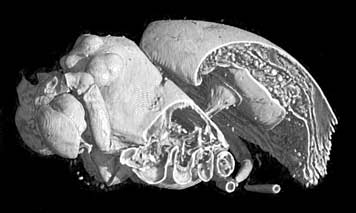Reviving a 50 Million Year Old Spider
Scientists at the University of Manchester, in the United Kingdom, digitally dissected a spider trapped in amber 50 million years ago in France using a technique called very high-resolution x-ray computed tomography. Based on the technology used in medical CAT scans, it can distinguish features about the width of a human hair. That minute level of detail allowed researchers to compare the creature’s internal organs with those of living spiders, and to classify the ancient arachnid as a unique species.

“This technique essentially generates full 3-D reconstructions of minute fossils and permits digital dissection of the specimen to reveal the preservation of internal organs,” said lead scientist David Penney in a press release from the university. “This is definitely the way forward for the study of amber fossils.”
The research was published in the current edition of the journal Zootaxa.

Keep Reading
Most Popular
Large language models can do jaw-dropping things. But nobody knows exactly why.
And that's a problem. Figuring it out is one of the biggest scientific puzzles of our time and a crucial step towards controlling more powerful future models.
How scientists traced a mysterious covid case back to six toilets
When wastewater surveillance turns into a hunt for a single infected individual, the ethics get tricky.
The problem with plug-in hybrids? Their drivers.
Plug-in hybrids are often sold as a transition to EVs, but new data from Europe shows we’re still underestimating the emissions they produce.
Google DeepMind’s new generative model makes Super Mario–like games from scratch
Genie learns how to control games by watching hours and hours of video. It could help train next-gen robots too.
Stay connected
Get the latest updates from
MIT Technology Review
Discover special offers, top stories, upcoming events, and more.